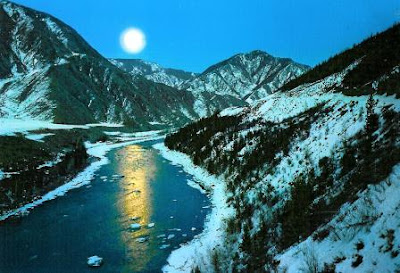All these official cards from Russia are showing some beautiful landscapes of the Golden Mountains of Altai. These mountains are one of the many russian UNESCO sites since 1998.
RU-5405484, sent by templar_phoenix.
The Altai mountains in southern Siberia form the major mountain range in the western Siberia biogeographic region and provide the source of its greatest rivers (...).
The region represents the most complete sequence of altitudinal vegetation zones in central Siberia, from steppe, forest-steppe, mixed forest, subalpine vegetation to alpine vegetation. The site is also an important habitat for endangered animal species such as the snow leopard. - in: http://whc.unesco.org/en/list/768
RU-345055, sent by Tanya.
"Katun is the main river at Altay and is famous for great rafting routes.
Katun is one of the major rivers at Altay, it's 688 km long and starts at the height of 2000 m at south Altay mountains, being fed by melting glaciers, smaller rivers, and Chuya river (along which passes Chuysky Trakt - the road to Mongolia).
From far, Katun looks like a green river, that is because there's a lot of limestone in the water, so the light is reflected in a strange way. Katun is not very wide: closer to Gorno-Altaysk it is just 20-30 meters wide and up towards the stream it may be 50 meters wide.
The stream in the river is quite strong, but it is possible to walk in at some places and swim a little bit, especially that the water during summer is not very cold. Katun is also great for fishing.
The main attraction of Katun is that for years, since the Soviet times, it has been a mecca for water tourism and rafting trips. Katun has a wide range of rapids of all kinds and complexities. It is a good place both for beginners and advanced rafters. There are a few annual rafting championships taking place at Katun." - in: http://www.waytorussia.net/Altay/Katun.html
RU-2761714, sent by Victoria.
Belukha is a twin-peaked mountain massif that rises along the border of Russia and Kazakhstan, just north of the point where these two borders meet those of China and Mongolia. There are several small glaciers on the mountain, including Belukha Glacier. Of the two peaks, the eastern peak (4,506 m, 14,784 ft.) is higher than the western peak (4,440 m, 14,567 ft.).
Belukha was first climbed in 1914 by the Tronov brothers. Most ascents of the eastern peak follow the same southern route as that taken in the first ascent. Though the Altai is lower in elevation than other Asian mountain groups, it is very remote, and much time and planning are required for its approach. - in: wikipedia






























